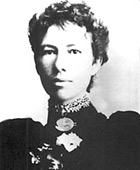Mary Gilmore was born near Goulburn, New South Wales. She became a teacher and a writer and was editor of the women's pages of the Australian Worker newspaper for 23 years.
In 1886, Gilmore went to Paraguay in South America to join a group of Australians who planned to set up a new colony where everyone would be equal and would work together. This colony was not successful.
After some years, Gilmore came back to Australia with her husband. She spent the rest of her life writing, doing her editing work and fighting for people who needed help. These included Aboriginal people, children who were forced to work in factories and shearers who were being underpaid. She also fought hard for women's rights.
In 1937 she was made Dame Mary Gilmore by King George VI. A suburb of Canberra is named after her and her picture is on the $10 note (along with Henry Lawson the only 2 Australian writers to be featured) and on a few of Australia's stamps.
Mary, Mary, Quite Contrary
Dame Mary Gilmore, Australia's 'grand old lady of letters', was the author of over twenty books, the subject of a controversial Dobell portrait, and later featured with Banjo Paterson on the first polymer $10 note.
In her final eight years, Dame Mary's life was a succession of visitors and housekeepers, sufficient to tax the health of any ninety year old.
Dame Mary, however, wouldn't have it any other way - she loved company and found several of her housekeepers tiresome and overbearing - a frequently reciprocated feeling.
Towards the end of 1954, after four months convalescence following an operation, Mary returned to her flat in Sydney's cosmopolitan Kings Cross.
Mary found her housekeeper, Trilbie Crombie, had resigned to go to Queensland. A 'succession of house-keepers' followed and 'some disastrous experiences' with help, as her official biographer, W. H. Wilde, recorded in Courage a Grace , one of several books covering Dame Mary's life and writing.
In November 1955 her doctor confined her to bed with pneumonia and pleurisy, and forbade any visitors. A Miss Lahey was retained as housekeeper, but throngs of visitors continued to arrive. 'They came in droves,' Mary wrote in her diary in early December, 'they keep me alive.'
On the eve of her ninety-first birthday in 1956, bookman Walter Stone arranged a tribute evening for Dame Mary at Paddington Town Hall, Sydney.
Hilda Lane was among the seven hundred guests. She was a niece of William Lane, leader of the utopian 'New Australia' settlement in Paraguay over sixty years earlier, and the first child born to the self-exiled Australian community.
Mary joined the colonists there as a schoolteacher in 1895; Hilda Lane became her close companion for Mary's remaining six years, visiting her flat weekly to look after her on the housekeeper's day off.
But Dame Mary's difficulties with housekeepers magnified when, after three years, Miss Lahey departed.
Walter Stone, Sydney bibliophile, arranged
91st birhday party with 700 guests for Dame Mary
Her biographer summed the situation:
'Mary seldom conceded that looking after her was an onerous task. All that was required was an able-bodied, mentally alert woman of impeccable honesty, spotless cleanliness, economical habits, inexhaustible patience and a strong preference for the Labor Party.'
Two other housekeepers came and went within a month.
Dame Mary had a 'succession of housekeepers'
through her flat in Kings Cross during late 1950's
Then Miss Sophie Moore arrived, with a single suitcase, in time for Christmas 1958 and lasted until mid-March.'When she left,' Mary noted in her diary, 'she needed almost a second taxi for her cases, parcels and bags - the empty house felt like heaven.'
Within a couple of days, Mary had retained an English nurse, Mrs Antoinette Ross, for the job. The recurring question about too many visitors arose shortly afterwards. Mrs Ross felt they placed a strain on Mary's health and suggested she would shut the door to them.
'Well,' Mary informed her firmly, 'I shall have to sit outside the door as I would want to see them'. The point was never raised again. The pair formed a comfortable relationship and when, a year later, Mrs Ross left to go to New Zealand, Mary wrote in her diary 'I will never be able to replace her. I feel like a homeless orphan today.'
Crowned 'May Queen' in
1961, Mary had "a strong preference for the Labor Party"
"Nothing I could say or do was right," Dame Mary diarised
While efforts were made to find another house-keeper, Mary enjoyed the company of an old friend, Hilda Lane.
Housekeepers literally came and went - nine in six months .
Mrs Renshaw, the first, changed her mind before arriving; Mrs Crawford survived for one day; then Miss Hayes, and Miss Voss, who, according to Mary, was 'the strangest person - nothing I could say or do was right'; Mrs Patterson went shopping one morning and never returned! And so the roll call continued.
Another applicant, Miss Waring, claimed to be an adoring Mary Gilmore fan. By the time her four months tour of duty concluded, her views had apparently changed. Mary's diary for 20 January 1961 reads 'she declared me to be arrogant and aggressive, and the greatest egomaniac she had ever known.'
Two weeks later, Miss Serisier filled the position. She, the diary shows, 'worshipped at the shrine of Woolworths' and once got lost going to Macleay Street, a short walk from Mary's Darlinghurst Road flat.
Fortunately, help was at hand. Mrs Ross returned from New Zealand in June 1961 and resumed her old post, staying until Mary's death eighteen months later. Dame Mary Gilmore, in her ninety-seventh year, suffered a sudden onset of broncho-pneumonia on 2nd December 1962 from which she did not recover.
She died clasping the hand of Mrs Antoinette Ross, her faithful housekeeper. |






